Backyard bird enthusiasts appreciate all native species. But there’s something extra special about bluebirds. The rush of joy when a bluebird visits our yard is often followed by research and the discovery that these beautiful cavity-nesting birds will use nest boxes.
It might seem simple enough: just buy or build a box, put it on a post, and wait for the bluebirds to move in.
But it’s important for would-be nest box hosts to understand that nest box management comes with much more responsibility, and some challenges that some might not be ready to take on.
The proper size and shape of the box, the size of the entrance hole, the height of the box, and baffles to prevent predators are all part of responsible nest-box management. (This applies to all nest boxes, not just those designed for bluebirds.)

I had an exchange with someone recently about the idea of trying to educate people on the risks and responsibilities associated with putting up nest boxes on their property. Some folks interpret attempts to educate people on the responsibilities associated with nest boxes as negative and/or rude. I thought my response to that might be helpful to others seeking to help people understand the importance of being a responsible nest box host.
There are any number of threats to nesting bluebirds, including snakes, ants, wasps, and parasitic blowflies. One of the most difficult challenges for a nest box host is what to do about house sparrows. These nonnative birds are fierce competitors for nesting cavities, including nest boxes. The harsh reality is that house sparrows often kill adult bluebirds and their nestlings in the box, and build their messy nests on top of the carnage below.

I monitored nearly 60 eastern bluebird boxes in a wildlife area for many years. As an animal lover, I was reluctant to do anything about the house sparrows nesting in the boxes. However, after seeing dozens of adult bluebirds and their nestlings killed by those non-native sparrows, in a very gruesome way, my feelings on the issue changed.
This is not about weighing the merit of house sparrows. This is about deciding whether or not you’re okay with killing bluebirds, and I don’t think anyone would feel good about facilitating that. Unless one is willing to manage house sparrows, European starlings, and other threats, you shouldn’t install nest boxes.

I also wanted to share a word of caution about decorative nest boxes. Adding a pretty bird house to your yard is fine, as long as you block the entrance hole. These boxes are rarely built with the safety of birds in mind, so preventing birds from using them is important.
Being a nest box host and helping native cavity nesters can be an intensely rewarding endeavor, but only if you’re a responsible host. Knowing and understanding the risks – and sharing that information with others – is important. It should not be viewed as discouraging or rude.
If you want to learn more about best practices for nest boxes, here’s a great resource that includes practical tips on nest box building, location, house sparrow management and more.




Thanks for writing this. After watching the whole process of nesting and laying eggs and feeding Young,It’s heartbreaking to see a whole nest of ready to fledge bluebirds dead from a house sparrow or a house wren. A little management can really help. it takes time and commitment but you learn a lot and it’s fun
It’s a great hobby if you have the summer off or you’re retired or just make it your priority, extracurricular activityThere’s a lot of observing involved so bring your camping chair and relax while you’re doing it. Keep notes of when incubation starts and when eggs hatch. This helps you know when to put up wren guard or sparrow spooker , read suggestions from other bird lovers . Try creating sparrow spooker for the top of the birdhouse. See sialis website. A piece of Mylar on a stick near the birdhouse won’t work.
Even with management, there are heartbreaks no matter how hard you work. But with some management, the successes outweigh the heart breaks!!
I and my monitors remove all HOSP eggs and nests from Nestboxes.
I have a nesting box and a few weeks ago I found the bluebird babies dead. She is now making a new best. How can I keep her safe?
We love bluebirds too and support nest box efforts in our community. I thought you might want to know that hitting windows are a big risk for the beautiful birds. One of the nation’s leading scientists has called on bluebird lovers everywhere to protect bluebirds from deadly collisions with windows. Read his letter to bluebird leaders at https://birdfriendlyyards.net/blog/ For info on how to protect them see the free “Consumer Guide to Bird Window Collision Prevention at https://birdfriendlyyards.net/consumerguide/
An added note: between 2000 and 2021, the bluebird boxes in our trail have successfully fledged 3,473 Western Bluebirds.
I read this opinion piece with interest, but I don’t share the author’s conclusions. I led a project to make 70 Western Bluebird nest boxes from cedar, built to the specifications recommended by the American Bluebird Society. These were placed in blue oak woodland, pasture land and along old fallowed farm fields.
In 25 years of monitoring and recording the nesting and fledging results in each year, we’ve never had a bluebird fatality caused by House Sparrows. There were three bluebird houses near a park, and since each kept being occupied by House Sparrows, these were eventually moved to a more outlying location and the sparrow occupation stopped.
Birds are in an area due to many other factors besides nest site availability. But one way of looking at it is this: every human-built nest box occupied by a House Sparrow or European Starling means that they are using one fewer natural cavity nesting site, like a dead tree limb, fence post or old apple trunk. This potentially frees up the natural cavity for use by bluebirds.
It is well-documented economics that increasing the housing supply leads to reduced competition and demand, not more, and marginal sites may not even be utilized if there is an abundance of choices. This is true of humans and birds.
You’ll get the most bluebird production out of bluebird houses that are monitored exclusively for them and not other species, of course, but I have yet to see evidence that putting up bluebird boxes without rigorous monitoring, and evicting of non-bluebirds, somehow “does more harm than good.” A claim like that should be supported by data, not just informed by hostility toward non-natives.
I too prefer bluebirds. But when it comes to putting up appropriate houses for them, built to the right dimensions, I do not discourage people from doing so just because they are unwilling or unable to monitor them. There are elderly residents who get a lot of pleasure from observing an occupied bluebird house on their property. I don’t think they need to feel shamed or compelled to either be the vigilant nesting police, or else never put up a bluebird house.
Thanks to anyone who cares about and helps birds, regardless of their opinion on this issue. We can disagree without being disagreeable.
Happy Trails,
Jon Hammond
I agree with your assessment. House sparrows are a real threat, and it takes time and effort, and some difficult choices. I cull house sparrows, but it is certainly no fun. But the rewards of having a successful fledging of bluebirds is worth the trouble, in my opinion. The baffle part is relatively easy and effective at keeping them safe from raccoons and other climbing predators.
If any of you
put metal guards over the holes in your bluebird boxes make double sure you set them exactly to the diameter of the holes. I tend about 60 bluebird boxes on a nearby farm. New boxes with the metal guards went up last winter. Some of the guards were off center. Result: four dead male bluebirds and a dead tree swallow.
An excellent piece. To be more specific and more blunt, your responsibility extends to euthanizing house sparrows either by killing adults (which is difficult) or by removing house-sparrow nests, eggs or nestlings. House sparrows make sloppy nests of grass and straw, often with feathers or pieces of plastic and paper. Bluebirds make neat nests, usually with pine needles. If you allow young house sparrows to fledge, they’ll imprint to boxes. The infestation will then expand like a virus. Your responsibility also extends to placing predator barriers on the poles supporting the boxes. Sometimes bluebird nests get infested with red ants or mites. They can kill nestlings. Take the infested nest out with a spatula. If there are eggs, carefully remove them and set them on soft tissues. Nuke the nest in a microwave, replace the eggs and put the nest back in the box. Bluebirds are now overwintering in most of the East. You can give them a head start for nesting by feeding them freeze-dried meal worms in winter. Avoid feeding boxes. They can trap and kill bluebirds. Bluebirds will have to share the meal worms with robins, starlings, tufted titmice, juncos, chickadees, etc. Expensive, but it is what it is.
Totally agree …it’s like you pray for rain but u still have to deal with the mud too